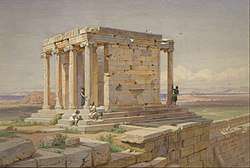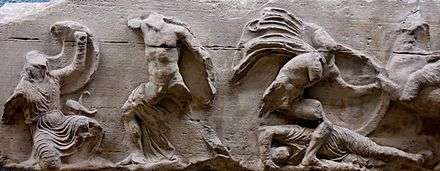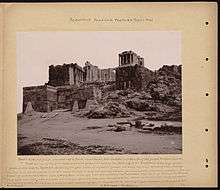Temple of Athena Nike
The Temple of Athena Nike (Greek: Ναός Αθηνάς Νίκης, Naós Athinás Níkis) is a temple on the Acropolis of Athens, dedicated to the goddess Athena Nike. Built around 420 BC, the temple is the earliest fully Ionic temple on the Acropolis. It has a prominent position on a steep bastion at the south west corner of the Acropolis to the right of the entrance, the Propylaea. In contrast to the Acropolis proper, a walled sanctuary entered through the Propylaea, the Victory Sanctuary was open, entered from the Propylaea's southwest wing and from a narrow stair on the north. The sheer walls of its bastion were protected on the north, west, and south by the Nike Parapet, named for its frieze of Nikai celebrating victory and sacrificing to their patroness, Athena Nike.


Nike means "victory" in Greek, and Athena was worshipped in this form, representative of being victorious in war. The citizens worshipped the goddess in hopes of a successful outcome in the long Peloponnesian War fought against the Spartans and their allies.
History

In the sixth century BCE a cult of Athena Nike was established and a small temple was built using Mycenaean fortification and Cyclopean masonry. After the temple was demolished by the Persians in 480 BCE a new temple was built over the remains. The new temple construction was underway in 449 BCE and was finished around 420 BCE. If still in use by the 4th-century, the temple would have been closed during the persecution of pagans in the late Roman Empire.
The temple sat untouched until it was demolished in 1686 by the Turks who used the stones to build defenses. In 1834 the temple was reconstructed after the independence of Greece. In 1998 the temple was dismantled so that the crumbling concrete floor could be replaced and its frieze was removed and placed in the new Acropolis Museum that opened in 2009.[1] The Temple of Athena Nike is often closed to visitors as work continues. The new museum exhibit consists of fragments of the site before the Persians were thought to have destroyed it in 480 BCE. Sculptures from the friezes have been salvaged such as: deeds of Hercules, statue of Moscophoros, a damaged sculpture of a goddess credited to Praxiteles and the Rampin horseman, as well as epigraphic dedications, decrees, and stelae.[2]
.jpg)
Architecture

The Temple of Athena Nike was finished around 420 BC,[3] during the Peace of Nicias. It is a tetrastyle (four column) Ionic structure with a colonnaded portico at both front and rear facades (amphiprostyle), designed by the architect Kallikrates. The columns along the east and west fronts were monolithic columns. The temple ran 8 metres (27 ft) long by 5.5 metres (18.5 ft) wide and 7 metres (23 ft) tall. The total height from the stylobate to the acme of the pediment while the temple remained intact was a modest 7 metres (23 ft). The ratio of height to diameter of the columns is 7:1, the slender proportions creating an elegance and refinement not encountered in the normal 9:1 or 10:1 of Ionic buildings. Constructed from white Pentelic marble, it was built in stages as war-starved funding allowed.
Cult statue and frieze
The famous frieze of Nike adjusting her sandal is an example of Wet drapery. Wet drapery involves showing the form of the body but also concealing the body with the drapery of the clothing. Some friezes are from the Persian and Peloponnesian wars. The friezes contained a cavalry scene from the battle of Marathon and a Greek victory over the Persians at the battle of Plataea. The battles represent Greek and Athenian dominance through military power and historical events.[4] A statue of Nike stood in the cella, or otherwise referred to as a naos. Nike was originally the "winged victory" goddess (see the winged Nike of Samothrace). The Athena Nike statue's absence of wings led Athenians in later centuries to call it Apteros Nike or wingless victory, and the story arose that the statue was deprived of wings so that it could never leave the city.
The friezes of the building's entablature were decorated on all sides with relief sculpture in the idealized classical style of the 5th century BC. The north frieze depicted a battle between Greeks entailing cavalry. The south frieze showed the decisive victory over the Persians at the battle of Plataea. The east frieze showed an assembly of the gods Athena, Zeus and Poseidon, rendering Athenian religious beliefs and reverence for the gods bound up in the social and political climate of 5th Century Athens.
Some time after the temple was completed, around 410 BC a parapet was added around it to prevent people from falling from the steep bastion. The outside of the parapet was adorned by carved relief sculptures showing Nike in a variety of activities and all in procession.[5]

Architects Christian Hansen and Eduard Schaubert excavated the temple in the 1830s. The building had been totally dismantled in the 17th century and the stone built into the Turkish wall that surrounded the hill. A primitive anastylosis was carried out in 1836 when the temple was re-erected from remaining parts. A third restoration was completed in Summer 2010.[6] The main structure, stylobate and columns are largely intact, minus the roof and most of the tympanae. Fragments of the sculpted frieze are exhibited in the Acropolis Museum and the British Museum; copies of these are fixed in their place on the temple.
See also
- List of Ancient Greek temples
- Architecture of Ancient Greece
- Art of Ancient Greece
- Classical architecture
- Classical sculpture
References
- N, James (December 2009). "The Acropolis and its new museum". Antiquity. 83 (322): 1144–1151.
- Duamato, Lamia (1980). The temple of Athena Nike. Monticello,Ill.:Vance Bibliographies.
- Hurwit, Jeffrey (2004). The Acropolis in the Age of Pericles. Cambridge University Press. p. 183. ISBN 0521527406.
- Gorham, Stevens (1908). "The Cornice of the Temple of Athena Nike". American Journal of Archaeology. 12 (4): 398–405.
- Rhodes, Robin (1995). Architecture and Meaning on the Athenian Acropolis. Cambridge University Press. p. 120. ISBN 0521469813.
- ACROPOLIS RESTORATION SERVICE
- Greek architecture Encyclopædia Britannica, 1968.
- Greece: From Mycenae to the Parthenon, Henri Stierlin, TASCHEN, 2004.
External links
| Wikimedia Commons has media related to Temple of Athena Nike (Athens). |
- Dr. J's Illustrated Temple of Athena Nike
- Temple of Athena Nike Frieze Pictures
- The temple of Athena Nike - Hellenic Ministry of Culture and Tourism
- Temple of Athena Nike, Athens
- Temple of Athena Nike, Athens
- Temple of Athena Nike, Athens
- The Temple of Athena Nike: A Small Shrine Dedicated To One of Athena's
- Temple of Athena Nike